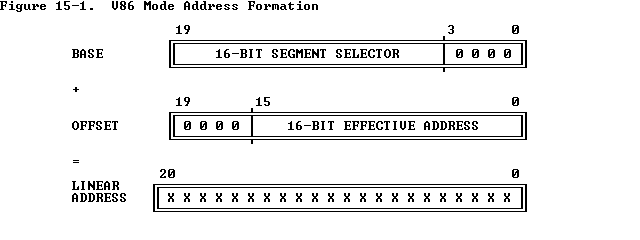up:
Chapter 15 -- Virtual 8086 Mode
prev:
Chapter 15 -- Virtual 8086 Mode
next: 15.2 Structure of a V86 Task
15.1 Executing 8086 Code
The processor executes in V86 mode when the VM (virtual machine) bit in the
EFLAGS register is set. The processor tests this flag under two general
conditions:
- When loading segment registers to know whether to use 8086-style
address formation.
- When decoding instructions to determine which instructions are
sensitive to IOPL.
Except for these two modifications to its normal operations, the 80386 in
V86 mode operated much as in protected mode.
15.1.1 Registers and Instructions
The register set available in V86 mode includes all the registers defined
for the 8086 plus the new registers introduced by the 80386: FS, GS, debug
registers, control registers, and test registers. New instructions that
explicitly operate on the segment registers FS and GS are available, and the
new segment-override prefixes can be used to cause instructions to utilize
FS and GS for address calculations. Instructions can utilize 32-bit
operands through the use of the operand size prefix.
8086 programs running as V86 tasks are able to take advantage of the new
applications-oriented instructions added to the architecture by the
introduction of the 80186/80188, 80286 and 80386:
- New instructions introduced by 80186/80188 and 80286.
- PUSH immediate data
- Push all and pop all (PUSHA and
POPA)
- Multiply immediate data
- Shift and rotate by immediate count
- String I/O
- ENTER and
LEAVE
- BOUND
- New instructions introduced by 80386.
- LSS,
LFS,
LGS instructions
- Long-displacement conditional jumps
- Single-bit instructions
- Bit scan
- Double-shift instructions
- Byte set on condition
- Move with sign/zero extension
- Generalized multiply
15.1.2 Linear Address Formation
In V86 mode, the 80386 processor does not interpret 8086 selectors by
referring to descriptors; instead, it forms linear addresses as an 8086
would. It shifts the selector left by four bits to form a 20-bit base
address. The effective address is extended with four high-order zeros and
added to the base address to create a linear address as
Figure 15-1
illustrates.
Because of the possibility of a carry, the resulting linear address may
contain up to 21 significant bits. An 8086 program may generate linear
addresses anywhere in the range 0 to 10FFEFH (one megabyte plus
approximately 64 Kbytes) of the task's linear address space.
V86 tasks generate 32-bit linear addresses. While an 8086 program can only
utilize the low-order 21 bits of a linear address, the linear address can be
mapped via page tables to any 32-bit physical address.
Unlike the 8086 and 80286, 32-bit effective addresses can be generated (via
the address-size prefix); however, the value of a 32-bit address may not
exceed 65,535 without causing an exception. For full compatibility with
80286 real-address mode, pseudo-protection faults (interrupt 12 or 13 with
no error code) occur if an address is generated outside the range 0 through
65,535.

up:
Chapter 15 -- Virtual 8086 Mode
prev:
Chapter 15 -- Virtual 8086 Mode
next: 15.2 Structure of a V86 Task

